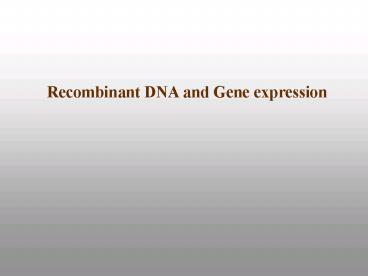Recombinant DNA and Gene expression - PowerPoint PPT Presentation
1 / 31
Title:
Recombinant DNA and Gene expression
Description:
The viral proteins include capsid proteins and reverse transcriptase (made in ... Affymetrix cassettes (12.7x12.7mm) Enclosed chip enables high-quality control ... – PowerPoint PPT presentation
Number of Views:94
Avg rating:3.0/5.0
Title: Recombinant DNA and Gene expression
1
Recombinant DNA and Gene expression
2
The reproductive cycle of HIV, a retrovirus
3
The lytic and lysogenic cycles of phage ?, a
temperate phage
4
Conjugation and recombination in E. coli
5
A process starts with breakage at the
corresponding points of the homologous strands of
two paired DNA duplexes. The breakage allows
movement of the free ends created by the nicks.
Each strand leaves its partner and crosses over
to pair with its complement in the other duplex.
6
Recombination is initiated by a double-strand
break, followed by formation of single-stranded
3 ends, one of which migrates to a homologous
duplex. A break must be made in one duplex in
order to generate a point from which single
strands can unwind to participate in genetic
exchange. Both strands of a duplex must be
broken to accomplish a genetic exchange.
7
Overview of gene cloning with a bacterial plasmid
8
Using restriction enzymes to make recombinant DNA
- Restriction enzymes Gene cloning and genetic
engineering were made possible by the discovery
of enzymes that cut DNA molecules at limited
number of specific location. - Restriction sites Hundreds of different
restriction enzymes have been identified. Each
enzyme is very specific, recognizing a particular
short DNA sequence at specific points within the
restriction site.
9
(No Transcript)
10
(No Transcript)
11
Genomic libraries
12
(No Transcript)
13
Nucleotides
14
Nucleic Acids
Phosphodiester bonds
15
Whole-genome shotgun approach to sequencing
16
(No Transcript)
17
(No Transcript)
18
Microarray Technology
- Microarray technology is emerging as a powerful
platform of biological exploration. - The technology are provided by some ideas for the
standardization of experimental design,
microarray formats, detection systems, data
outputs, and software tools.
19
(No Transcript)
20
Biological questions and the microarray life cycle
- Gene expression in biological processing in cell
- Gene expression between different biosystems,
animals, even organs - Gene expression with dynamics and dependence
- ???????????
21
(No Transcript)
22
The processing of the microarray experiment
- Sample preparation, mRNA amplification and
labeling - Hybridization, image scanning and digitization
- Data analysis and mining
23
Sample preparation, mRNA amplification and
labeling
Sample preparation
Microarray assays generate a large data flow,
placing a premium on high-quality nucleic acid
samples.
RNA degradation
24
Sample preparation, mRNA amplification and
labeling
mRNA amplification and labeling
- T7-based RNA amplification scheme
- mRNA reverse transcription with primer conjugated
T7 promoter - Amplification RNA and labeling with T7 polymerase
Comparing DNA amplification with PCR method,
T7-based RNA amplification scheme is a linear
process, skewing of resultant amplified RNA
population relative to the input mRNA is
minimized.
Output garbage
Input dust
25
(No Transcript)
26
Microarray Tools and Technologies
27
Two color comparative micoarray
28
Hybridization, image scanning and digitization
Hybridization
- Hybridization buffer condition
- Sample concentration
- Temperature
29
Hybridization, image scanning and digitization
Image scanning and digitization
Data quantification and quality measurement
Preobjective scanning
Charge-coupled device
30
Data analysis and mining
- Normalization and transformation
- Data visualization
- Cluster analysis
31
Gene therapy using a retroviral vector































